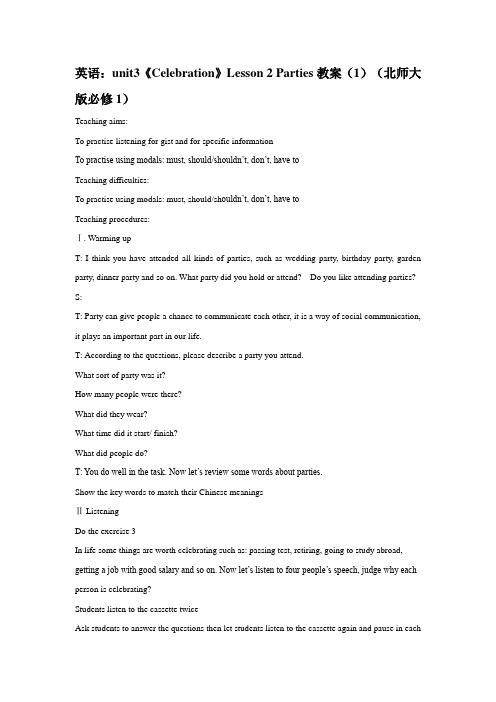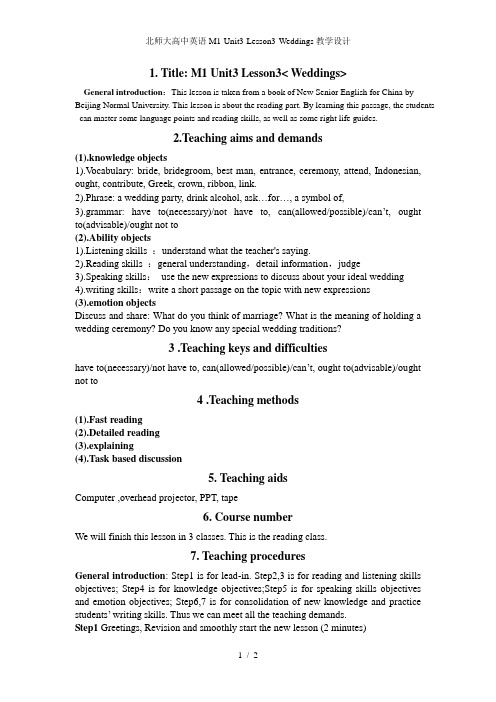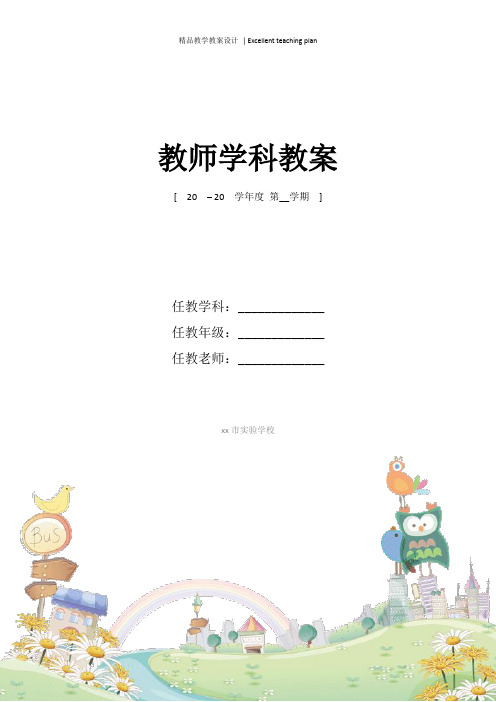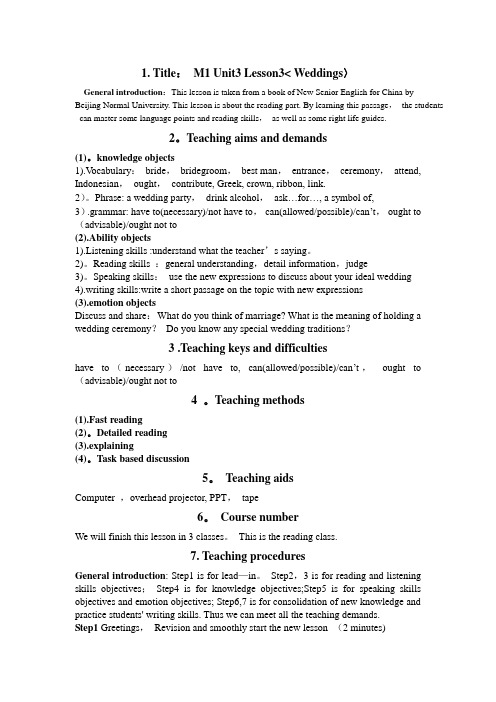Unit3《Celebration》Lesson3 Weddings教案2(北师大版必修1)
- 格式:doc
- 大小:43.00 KB
- 文档页数:3

英语:unit3《Celebration》Lesson 2 Parties教案(1)(北师大版必修1)Teaching aims:To practise listening for gist and for specific informationTo practise using modals: must, should/shouldn’t, don’t, have toTeaching difficulties:To practise using modals: must, should/sh ouldn’t, don’t, have toTeaching procedures:Ⅰ. Warming upT: I think you have attended all kinds of parties, such as wedding party, birthday party, garden party, dinner party and so on. What party did you hold or attend? Do you like attending parties? S:T: Party can give people a chance to communicate each other, it is a way of social communication, it plays an important part in our life.T:According to the questions, please describe a party you attend.What sort of party was it?How many people were there?What did they wear?What time did it start/ finish?What did people do?T: You do well in the task. Now let’s review some words about parties.Show the key words to match their Chinese meaningsⅡ ListeningDo the exercise 3In life some things are worth celebrating such as: passing test, retiring, going to study abroad, getting a job with good salary and so on. Now let’s listen to four people’s speech, judge why each person is celebrating?Students listen to the cassette twiceAsk students to answer the questions then let students listen to the cassette again and pause in eachparagraph.Do the exercise 4When we attend a party we should follow social customs. what do you think should we do in parties?S:Now read through the advice, trying to complete the sentences and predicting what the answers will be.We will listen to about advice about how to behave in parties. (play the cassette for students to check their answers.IIISpeakingDo the exercise 5and 6Suppose you have a foreign friend who receives a invitation to a party.What to wear; What presents to take , When to arriveWhat to say, What not to do, When to leave,Divide students into groups to do the exerciseDo the exercise 7Ask students to match the expressions with different situation.IV Homework。

1. Title: M1 Unit3 Lesson3< Weddings>General introduction:This lesson is taken from a book of New Senior English for China by Beijing Normal University. This lesson is about the reading part. By learning this passage, the students can master some language points and reading skills, as well as some right life guides.2.Teaching aims and demands(1).knowledge objects1).V ocabulary: bride, bridegroom, best man, entrance, ceremony, attend, Indonesian, ought, contribute, Greek, crown, ribbon, link.2).Phrase: a wedding party, drink alcohol, ask…for…, a symbol of,3).grammar: have to(necessary)/not have to, can(allowed/possible)/can’t, oughtto(advisable)/ought not to(2).Ability objects1).Listening skills :understand what the teacher's saying.2).Reading skills :general understanding,detail information,judge3).Speaking skills:use the new expressions to discuss about your ideal wedding4).writing skills:write a short passage on the topic with new expressions(3).emotion objectsDiscuss and share: What do you think of marriage? What is the meaning of holding a wedding ceremony? Do you know any special wedding traditions?3 .Teaching keys and difficultieshave to(necessary)/not have to, can(allowed/possible)/can’t, ought to(advisable)/ought not to4 .Teaching methods(1).Fast reading(2).Detailed reading(3).explaining(4).Task based discussion5. Teaching aidsComputer ,overhead projector, PPT, tape6. Course numberWe will finish this lesson in 3 classes. This is the reading class.7. Teaching proceduresGeneral introduction: Step1 is for lead-in. Step2,3 is for reading and listening skills objectives; Step4 is for knowledge objectives;Step5 is for speaking skills objectives and emotion objectives; Step6,7 is for consolidation of new knowledge and practice students’ writing skills. Thus we can meet all the teaching demands.Step1 Greetings, Revision and smoothly start the new lesson (2 minutes)Step2 Fast-reading and search for the answer for "T" or "F" questions, general understanding. (8minutes)”You can go to the wedding ceremony without asking first when you are not a close family member in Indonesia. T or F”, ”Weddings in Greek consist of mainly two parts: the church ceremony and the wedding reception. T or F”Step3 Detailed reading and look for the information needed . The ability to get detail information. (9minutes)”In Indonesia, you have to put money into a box at the entrance to the wedding reception. T or F”, “The bride groom has to ask the bride’mother or father for the bride’ hand?”, “Why do people throw dishes on the floor and put money on the bride’s wedding dress?”Step4 Explain the use of new words, phrases and difficult sentences under the help of some teaching equipments.(10minutes)Step5 Task-based language(10minutes)Discuss with your partner about what is your ideal wedding. Talk about some special wedding traditions you know. Raise your hand to answer the question.Step6Summary the lesson, with related exercises. Mention the emotional objects.(5minutes), say bye.Step7 Homework(1minute)(1).Do exercise 6、7、8 in the exercise part of the book. This is used to make the students have a further understanding of new words and new grammars.(2).write a short passage about your ideal wedding.(at least 100 words)8. Blackboard designIn order to make the blackboard design clearly and neatly, I will divide the blackboard into three parts. On the left, I’ll write teaching aims; in the middle of the blackboard, there should beName:Hu RonghuaDate:2012.5.12。


1. Title:M1 Unit3 Lesson3< Weddings〉General introduction:This lesson is taken from a book of New Senior English for China by Beijing Normal University. This lesson is about the reading part. By learning this passage,the students can master some language points and reading skills,as well as some right life guides.2。
Teaching aims and demands(1)。
knowledge objects1).V ocabulary:bride,bridegroom,best man,entrance,ceremony,attend, Indonesian,ought,contribute, Greek, crown, ribbon, link.2)。
Phrase: a wedding party,drink alcohol,ask…for…, a symbol of,3).grammar: have to(necessary)/not have to,can(allowed/possible)/can’t,ought to (advisable)/ought not to(2).Ability objects1).Listening skills :understand what the teacher’s saying。
2)。
Reading skills :general understanding,detail information,judge3)。
Speaking skills:use the new expressions to discuss about your ideal wedding4).writing skills:write a short passage on the topic with new expressions(3).emotion objectsDiscuss and share:What do you think of marriage? What is the meaning of holding a wedding ceremony?Do you know any special wedding traditions?3 .Teaching keys and difficultieshave to(necessary)/not have to, can(allowed/possible)/can’t,ought to (advisable)/ought not to4 。
![[北师大版必修一教案]Unit 3 Celebration Lesson 3 Weddings](https://img.taocdn.com/s1/m/79fe8a9ef8c75fbfc67db256.png)
Unit 3 CelebrationLesson 3 Weddings一、教学目标1. 认读有关婚礼的相关词汇;2. 通过略读理解文章段落大意;3. 了解英语国家人们在行为举止和待人接物等方面与中国人的异同;4. 运用所学词汇设计自己或者朋友将来的婚礼;二、重点难点学习有关婚礼的相关词汇提高学生通过略读理解文章段落大意的能力三、教学过程讲授Step1Explain learning objectives[PPT 2-5]让学生明确本节课的目标和教学目的Step2Brain-stormingWords related to weddings[PPT 6–14][学案I]唤醒激活学生已有的知识Pre-readingStep3Ask the students to Match the words to their definition.[PPT15 ][学案Ⅱ⑴]让学生掌握与话题有关的词汇和相关知识。
在语境中呈现单词,帮助学生理解、记忆生词, 为阅读做好准备。
在语境中再现生词,强化学生的瞬时记忆。
Step4Help the students to memorize words[PPT 16-17][学案Ⅱ⑵]Step5The wedding styles[PPT18-27][学案Ⅲ]While-reading 25’Step 6Ss enjoy the pictures of Indonesian Weddings[PPT29]学生观看图片,了解外国的风俗习惯,根据图片预测阅读内容,帮助学生理解课文,培养学生利用背景知识进行阅读的策略。
Step 7Ss read the text and find out the main idea of the passage.[PPT29]学生阅读课文,了解文章大意,培养学生归纳总结的能力。
Step 8Ss read the text again and find out Dos and Don’ts in the Indonesian weddings. And then Ss share with the whole class.[PPT30][学案IV Part One]细读,了解详细内容。

Celebration-Lesson 3 Weddings学案(北师大版必修一Unit3)【教学目标】1. To read a text for specific information.2. To practice using modals: have to /have not to; can /can’t; ought to/ ought not to.3. To discuss the traditional Chinese wedding customs.4. To make a plan for your future wedding.【教学重点】1.Promise during the wedding:To have and to hold from this day forward, for better, for worse, for richer,for poorer, in sickness and in health, to love and to cherish, till death do uspart.2.Key word bankWedding3.Review:turn to page40,and match the new words and the definitions.4.⑴Read the first article: In Indonesia WeddingWhat to do:What not to do:⑵Read the second article: Greek WeddingBefore the ceremony:During the ceremony:After the ceremony:5. Review what we have concluded from the two articles, and try to find some useful words.【讨论】1 Take the two articles as an example, and have a discussion in groups.What is the traditional wedding customs?【练习】Take the two articles as an example, and have a discussion in groups.What is the traditional wedding customs?。
Unit 3 Celebrations----weddings (学案)Objectives: (学习目标)1. understand the words about weddings;2. read passages to find detail information of their wedding customs;3. know about two foreign countries' wedding customs.4. learn to give simple advice about the wedding customs to f riends Before-- Reading -----watch two short videos-----15mins Thinking and speaking -----share with the whole classQ1.What do they celebrate ?Q2. How do the people feel in the video ?Q3. Do their wedding customs have something in common?Task 1 . Guess and match the meaning of the new words related weddings on page 40.While-- Reading -----25minsTask 2. ScanningQ1. Choose the answer :What’s the main idea of the passage?Q2. Find out what to do and what not to do in Indonesia in the first passage. (画在教材上) ----group workTask 3. Careful reading of Greek weddings---group workPost-Reading and summary --15minsTask 4. Speaking and sharingSpeak 3 sentences from the lesson to tell your friends about the customs in Indonesia and Greek .E.g. If you attend a Greek wedding, you can/can't .....you have to/don’t have to ......you ought to /ought not to......Task 5 . How to understand the sentence “when in Rome, do as the Romans do ”Task 6. SummaryWrite down the Chinese meaning of these words.1. bride ______2. bridegroom ________3. best man __________4. bridesmaids _________5. ceremony _______6. entrance ___________7. wedding reception_________8.crown__________9. flower bouquet____________。
U3 CelebrationLesson 3 WeddingsTeaching aims:To read a text for new information about weddingsTo practise using modals: have to/ not have to , can/ can’t , ought to / ought not toTo discuss the customs about weddingsTo write an account of a typical wedding.Teaching important pointsT o practice reading in order to understand the main idea of each paragraph and guess the meaning of new words from the context.Teaching difficulties:To practise using modals: have to/ not have to , can/ can’t , ought to / ought not toHow to grasp the main idea and structure of a passageHow to form their idea and express themselves in EnglishTeaching Aids: Board; multi-mediaTeaching procedures:Step ⅠRevisionT:Last period ,we learned a lot of celebrations;Do you remember them?Ss: They are...(birthday party,dragon boat festival,New Year’s Day,Christmas Day,etc.) T: Which one do you think is the most important ? And why?Ss:In my opinion,one kind of celebration is very important.It has only one time in my life.After it, I will have a new family.Several years later,I will have a baby,his name is Jr.Bush.Please guess what it is?( wedding。
A Teaching plan for Unit3 Cel ebration
Lesson 3 Weddings
Teaching goals
1.target language
a.Key words and phrases
bride; bridegroom; best man; entrance; invitation; even if; ceremony; attend; Indonesian;
ought; contribute; Greek; crown; ribbon; link
b. Key sentences
①. If you are a man, you ought to wear a tie.
②. You don’t have to contribute a lot of money.
③. You ought not to go to the ceremony because it is only for close family.
④. There is a lot of eating, drinking and dancing, including the famous Greek circle dance, where
everyone joins in.
⑤. On the day of Greek wedding ceremony, the bridegroom has to ask the bride’s father for his
daughter’s hand in marriage.
⑥. A long silk ribbon that links the crowns is a symbol of a long and happy life for the couple.
2. Ability goals
Enable the students to know two typical weddings.
Develop students’ ability of basic reading strategies of bottom-up and top-down.
3. Learning ability goals
To read a text for specific information.
To read a text for new information.
By using the strategies of bottom-up and top-down, students will learn to generalize and collect information.
Teaching important points
To practice reading in order to understand the main idea of each paragraph and guess the meaning of new words from the context.
Important words and phrases.
Teaching difficult points
Guide the students to pick out the main clue of the passage and the development method of the
text.
Students may mistakes with the use of the infinitive with or without to.
Teaching methods
1. Team work learning.
2. Task-based learning.
Teaching aids
A projector and some slides.
Teaching procedures
Step ⅠRevision
Task one: check words and expressions
T: Let’s check the homework.
Step ⅡLead-in
Task one: T: In this unit, we’re learning a lot about celebration. And this lesson, we’re going to read two passages about weddings. The first has been adapted from a website giving advice to English-speaking people working in Indonesia. And the second is about weddings in Greece. Step ⅢPre-reading
Task one: Background information input.
T: Now please turn to Page40 and look at Before you start and Exercise1.
Encourage students to talk about weddings they have been to. Use the opportunity to elicit or present useful vocabulary for the topic, e.g. reception, bride, bridegroom, ceremony.
Task two: Exercise2. Students look at the words and see if they can guess the meanings of some of the words from their knowledge of other words in English.
Step ⅣWhile-reading
Task one: Read to learn
Exercise3. Ask students if they have tried to find information about customs (not necessarily) in other countries on the Internet—If so, what did they find out?
Students read the statements first and predict what the answers will be.
Then they read the texts and find out if their predictions were correct.
Step ⅤPost-reading
Task one: Questions and Answers
T: Now let’s check the answers.
When checking students’answers, ask them to read out the section of text that gives the information and to correct the false statements.
Task two: Pair work
In pairs, students study the text again and write down three “true/false” statements of their own. All the students then close their books and, in turn, say one of their statements and the rest of the class says whether it is true or false. (1.F 2.F 3.T 4.T 5.F 6.T)
Step ⅥDiscussion
Task one: Read and discuss
Get students to read the text and discuss in pairs.
Task two: Discuss and explore
Ask students to discuss the main idea and what they’ve learnt from the text.
Step ⅦHomework
1. Go over the words and phrases.
2. Finish off the exercises in Language Power.。